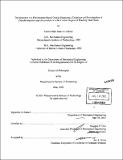| dc.contributor.advisor | Douglas P. Hart. | en_US |
| dc.contributor.author | Hidrovo Chavez, Carlos Hiller | en_US |
| dc.contributor.other | Massachusetts Institute of Technology. Dept. of Mechanical Engineering. | en_US |
| dc.date.accessioned | 2005-09-26T19:16:47Z | |
| dc.date.available | 2005-09-26T19:16:47Z | |
| dc.date.copyright | 2001 | en_US |
| dc.date.issued | 2001 | en_US |
| dc.identifier.uri | http://hdl.handle.net/1721.1/28233 | |
| dc.description | Thesis (Ph.D.)--Massachusetts Institute of Technology, Dept. of Mechanical Engineering, 2001. | en_US |
| dc.description | Includes bibliographical references (leaves 200-203). | en_US |
| dc.description.abstract | Seals are, arguably, the single most important component in any complex machine. Seals maintain lubrication and prevent the ingestion of contaminants into bearing surfaces, allowing high tolerance components to function reliably. Consequently, the performance of seals can be directly linked to the performance, life span and reliability of virtually all equipment of any complexity. Investigation of the failure of these components due to external contaminants ingestion and lubrication breakdown is of particular importance. To facilitate the study of the lubricant behavior, a unique non-invasive two-dimensional optical technique which allows instantaneous measurement of the lubricating film thickness and temperature was developed. The technique is based on the use of Laser Induced Fluorescence (LIF). In its simplest form, LIF has a number of limitations and shortcomings. In the past, it has been mostly used as a tracer for qualitative purposes, seeing limited use as a quantitative tool. This stems primarily from the dependence of fluorescence on exciting light intensity, rendering the emission useful only as a tagging indicator. In order to use the fluorescent emission as a signal for highly accurate quantitative measurements, a dual emission ratiometric approach that suppresses excitation intensity information was implemented. The concept is to use one emission as the carrier of the desired information, while the other emission provides the excitation intensity information. | en_US |
| dc.description.abstract | (cont.) Film temperature measurements require optically thin conditions and a strong dependence on temperature of one fluorescent emission. Film thickness measurements were performed using an innovative approach that requires an optically thick fluorescence system that portrays reabsorption of one fluorescent emission. Alluding to this requisite, the new technique was termed Emission Reabsorption Laser Induced Fluorescence (ERLIF) and along with the temperature measurement approach they are presented and discussed in the first part of this thesis. The second part of this thesis addresses the particulars of the investigation carried out on rotating shaft seals, in specific on the particle ingestion mechanics that lead to the failure of these components. A correlation between dust particle ingestion and the hydrodynamically generated "reverse pumping" mechanism was established through a joint schedule of experimental testing and analytical/numerical modeling. | en_US |
| dc.description.statementofresponsibility | by Carlos Hiller Hidrovo Chávez. | en_US |
| dc.format.extent | 203 leaves | en_US |
| dc.format.extent | 14848404 bytes | |
| dc.format.extent | 14874310 bytes | |
| dc.format.mimetype | application/pdf | |
| dc.format.mimetype | application/pdf | |
| dc.language.iso | en_US | |
| dc.publisher | Massachusetts Institute of Technology | en_US |
| dc.rights | M.I.T. theses are protected by copyright. They may be viewed from this source for any purpose, but reproduction or distribution in any format is prohibited without written permission. See provided URL for inquiries about permission. | en_US |
| dc.rights.uri | http://dspace.mit.edu/handle/1721.1/7582 | |
| dc.subject | Mechanical Engineering. | en_US |
| dc.title | Development of a fluorescence based optical diagnostics technique and investigation of particle ingestion and accumulation in the contact region of rotating shaft seals | en_US |
| dc.type | Thesis | en_US |
| dc.description.degree | Ph.D. | en_US |
| dc.contributor.department | Massachusetts Institute of Technology. Department of Mechanical Engineering | |
| dc.identifier.oclc | 48925797 | en_US |
